
Felix M Key
@keyfm.bsky.social
Research Group Leader @mpiib_berlin.
#Genetics of clinical and ancient #microbes to understand the #evolution of #infectious #diseases and the #microbiome
mpiib-berlin.mpg.de/2003543/key-lab
#Genetics of clinical and ancient #microbes to understand the #evolution of #infectious #diseases and the #microbiome
mpiib-berlin.mpg.de/2003543/key-lab
Despite many of the metagenomic pathogen signatures being very low coverage, we could confidently place two species, Erysipelothrix rhusiopathiae and Streptococcus lutetiensis, within their respective genetic diversity, providing additional evidence for their ancient authenticity.


February 24, 2025 at 12:17 PM
Despite many of the metagenomic pathogen signatures being very low coverage, we could confidently place two species, Erysipelothrix rhusiopathiae and Streptococcus lutetiensis, within their respective genetic diversity, providing additional evidence for their ancient authenticity.
Investigating the DNA we find 116 pathogen DNA signatures from 29 different (opportunistic) pathogens, including the zoonotic pathogen Salmonella enterica. Notably, all signals originating from a bone sample, were from bones with evidence of a paleopathological lesion.
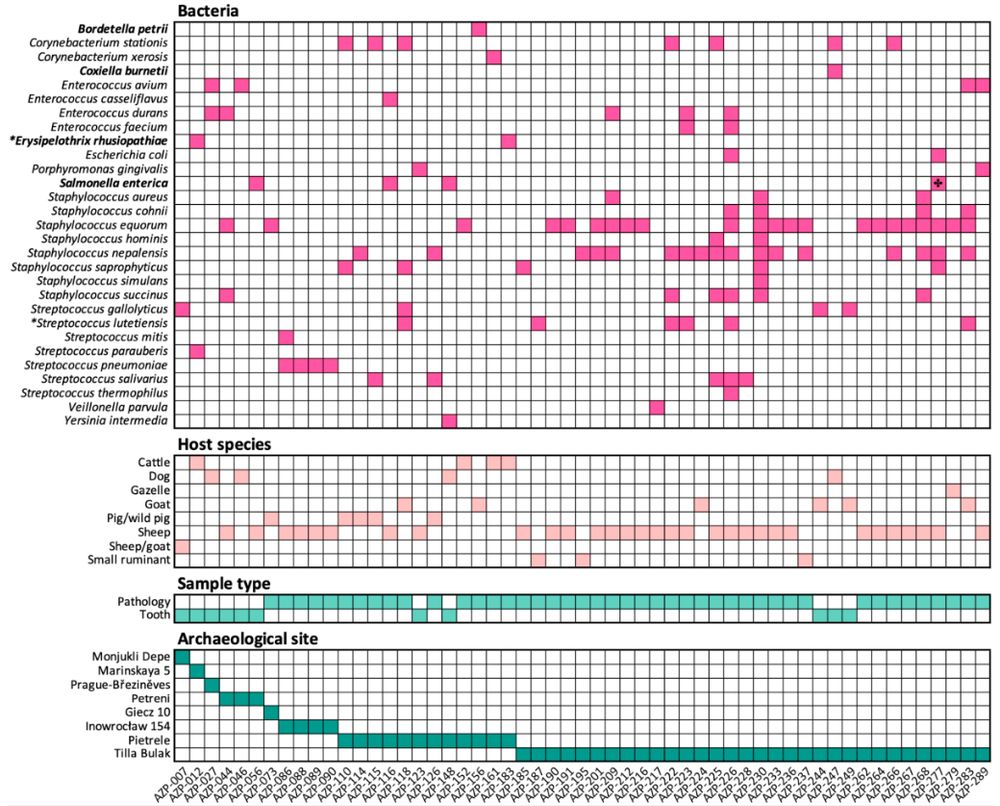
February 24, 2025 at 12:16 PM
Investigating the DNA we find 116 pathogen DNA signatures from 29 different (opportunistic) pathogens, including the zoonotic pathogen Salmonella enterica. Notably, all signals originating from a bone sample, were from bones with evidence of a paleopathological lesion.
Paleopathological lesions can be indicative of disease and may point to promising sampling locations for pathogen DNA. We collected 189 bones with different lesions including periostitis, lytic lesions and alveolar recession indicative of, though not specific to, infectious disease.

February 24, 2025 at 12:15 PM
Paleopathological lesions can be indicative of disease and may point to promising sampling locations for pathogen DNA. We collected 189 bones with different lesions including periostitis, lytic lesions and alveolar recession indicative of, though not specific to, infectious disease.
To overcome particular ante- and post-mortem challenges in pathogen DNA retrieval from animal remains, e.g. likely slaughtered when healthy, heat exposure during food preparation, and archaeological deposition, we sampled not just teeth but also bones w/ and w/o paleopathological lesions.

February 24, 2025 at 12:14 PM
To overcome particular ante- and post-mortem challenges in pathogen DNA retrieval from animal remains, e.g. likely slaughtered when healthy, heat exposure during food preparation, and archaeological deposition, we sampled not just teeth but also bones w/ and w/o paleopathological lesions.
We analyzed 346 specimens collected from 34 sites from Germany to Central Asia incl. different domesticates 🐑🐐🐖🐂. Our transect focuses on the Bronze age, a period implied in the emergence and spread of prehistoric zoonotic diseases.

February 24, 2025 at 12:13 PM
We analyzed 346 specimens collected from 34 sites from Germany to Central Asia incl. different domesticates 🐑🐐🐖🐂. Our transect focuses on the Bronze age, a period implied in the emergence and spread of prehistoric zoonotic diseases.
We propose a scenario for LNBA transmission combining ancient DNA and extant epidemiology, where sheep serve as a bridge host from a wild reservoir, bringing the pathogen more readily into contact with humans and increasing human and sheep infection risk.

February 10, 2025 at 5:24 PM
We propose a scenario for LNBA transmission combining ancient DNA and extant epidemiology, where sheep serve as a bridge host from a wild reservoir, bringing the pathogen more readily into contact with humans and increasing human and sheep infection risk.
But how was the LNBA lineage maintained? Where humans, and possibly sheep, the reservoir? We identify parallel evolution on the tips exclusively of the ancient lineage. Those repeated dead-end mutations may represent adaptation during independent spillovers. The overall reservoir remains at large!

February 10, 2025 at 5:23 PM
But how was the LNBA lineage maintained? Where humans, and possibly sheep, the reservoir? We identify parallel evolution on the tips exclusively of the ancient lineage. Those repeated dead-end mutations may represent adaptation during independent spillovers. The overall reservoir remains at large!
Despite its vast spatial and temporal spread we do not observe a phylogeographic structure of the LNBA lineage - instead a ‘ladder-like’ single lineage. Why? We identify that unlike the extant diversity, the LNBA lineage evolved under purifying selection, contributing to its phylogeographic pattern.

February 10, 2025 at 5:22 PM
Despite its vast spatial and temporal spread we do not observe a phylogeographic structure of the LNBA lineage - instead a ‘ladder-like’ single lineage. Why? We identify that unlike the extant diversity, the LNBA lineage evolved under purifying selection, contributing to its phylogeographic pattern.
Interestingly, we observe stepwise loss of ancestral genes within the LNBA lineage that are in part independently repeated during the evolution of the extant Y. pestis diversity with some of the genes implicated in virulence phenotypes of Y. pseudotuberculosis.

February 10, 2025 at 5:21 PM
Interestingly, we observe stepwise loss of ancestral genes within the LNBA lineage that are in part independently repeated during the evolution of the extant Y. pestis diversity with some of the genes implicated in virulence phenotypes of Y. pseudotuberculosis.
Exploring the genetic makeup of the LNBA lineage overall from the perspective of its ancestor - Y. pseudotuberculosis - we identify a retention of ancestral gene content on the LNBA lineage distinct from later historical ancient and extant Y. pestis.
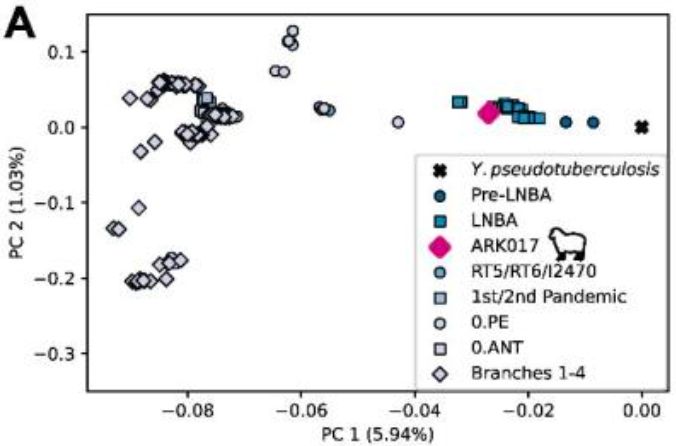
February 10, 2025 at 5:20 PM
Exploring the genetic makeup of the LNBA lineage overall from the perspective of its ancestor - Y. pseudotuberculosis - we identify a retention of ancestral gene content on the LNBA lineage distinct from later historical ancient and extant Y. pestis.
Similar to human-derived genomes, ARK017 shares the strong correlation in pairwise temporal and genetic distance rendering it indistinguishable from human infections suggesting that sheep husbandry elevated the risk for transmission to and from humans.
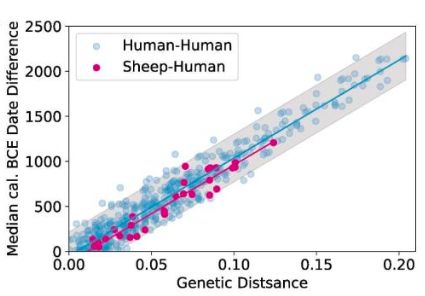
February 10, 2025 at 5:19 PM
Similar to human-derived genomes, ARK017 shares the strong correlation in pairwise temporal and genetic distance rendering it indistinguishable from human infections suggesting that sheep husbandry elevated the risk for transmission to and from humans.
ARK017 is part of the Late Neolithic Bronze Age (LNBA) lineage, a seemingly extinct pestis lineage so far exclusively identified from human ancient DNA. ARK017 shares features expected from what we know of the human infections lacking key gene configurations impacting flea-based transmission.
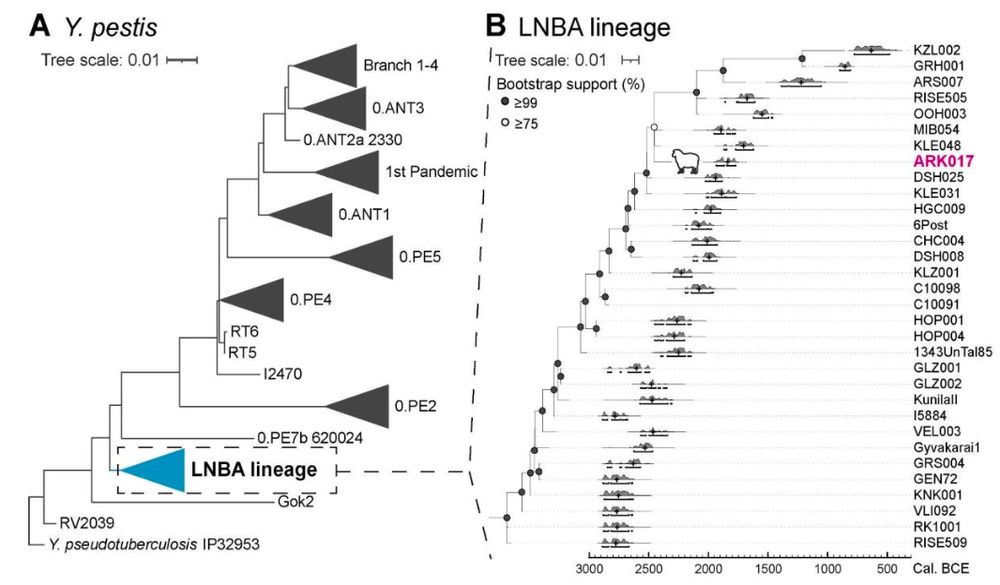
February 10, 2025 at 5:17 PM
ARK017 is part of the Late Neolithic Bronze Age (LNBA) lineage, a seemingly extinct pestis lineage so far exclusively identified from human ancient DNA. ARK017 shares features expected from what we know of the human infections lacking key gene configurations impacting flea-based transmission.
Here we investigated ancient DNA from sheep and cattle remains from the archeological site of Arkaim, part of the pastoralist Sintashta-Petrovka culture and we identified Y. pestis in a tooth from a domesticated sheep - ARK017.
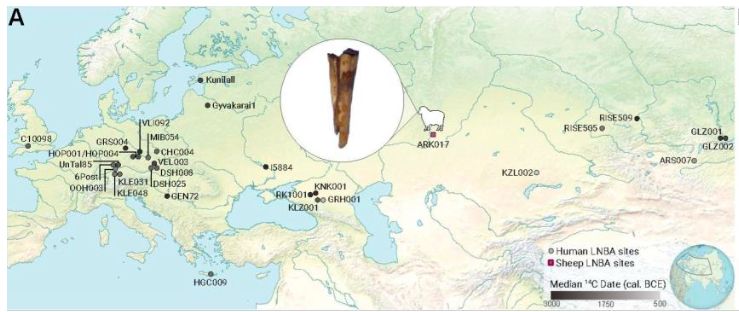
February 10, 2025 at 5:13 PM
Here we investigated ancient DNA from sheep and cattle remains from the archeological site of Arkaim, part of the pastoralist Sintashta-Petrovka culture and we identified Y. pestis in a tooth from a domesticated sheep - ARK017.

